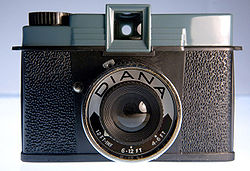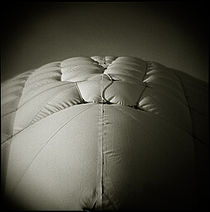
Toy camera
Encyclopedia



Box camera
The box camera is, with the exception of the pin hole camera, a camera in its simplest form. The form of the classic box camera is no more than a cardboard or plastic box with a lens in one end and film at the other. A simple box camera has only a single element meniscus fixed focus lens and...
s made almost entirely out of plastic
Plastic
A plastic material is any of a wide range of synthetic or semi-synthetic organic solids used in the manufacture of industrial products. Plastics are typically polymers of high molecular mass, and may contain other substances to improve performance and/or reduce production costs...
, often including the lens
Photographic lens
A camera lens is an optical lens or assembly of lenses used in conjunction with a camera body and mechanism to make images of objects either on photographic film or on other media capable of storing an image chemically or electronically.While in principle a simple convex lens will suffice, in...
. The term is misleading, since they are not merely 'toys' but are in fact capable of taking photographs. Many were made to be given away as novelties or prizes. The Diana, an inexpensive 1960s 4x4cm novelty box camera from Hong Kong, is typically the camera most associated with the term 'toy camera'. Other cameras, such as the LOMO LC-A
Lomo LC-A
The LOMO LC-A is a fixed lens, 35 mm film, leaf shutter, zone focus, compact camera introduced in 1984. The design is based on the Cosina CX-2....
, Lubitel
Lubitel
Lubitel refers to any of the several medium format twin-lens reflex cameras manufactured in Russia by LOMO.The design is based on the early 1930's Voigtländer Brillant camera with various improvements....
, and Holga
Holga
The Holga is a medium format 120 film toy camera, made in China, known for its low-fidelity aesthetic.The Holga's low-cost construction and simple meniscus lens often yields pictures that display vignetting, blur, light leaks, and other distortions...
, while originally intended as consumer, mass-market cameras, have also become identified with the term.
Many professional photographers have utilized toy cameras and the often strange optical effects of their inexpensive lenses to take award-winning photographs. Toy camera photography has been widely exhibited at many popular art shows, such as the annual show at the Soho Photo Gallery in the Tribeca
TriBeCa
Tribeca is a neighborhood in Lower Manhattan, New York in the United States. Its name is an acronym based on the words "Triangle below Canal Street", and is properly bounded by Canal Street, West Street, Broadway, and Vesey Street...
neighborhood of New York City. Various publications such as Popular Photography magazine have extolled the virtues of the Diana camera in its own right as an "art" producing image maker. Several books have also featured the work of toy cameras, such as The Friends of Photography's "The Diana Show", "Iowa" by Nancy Rexroth, and "Angels at the Arno" by Eric Lindbloom.

